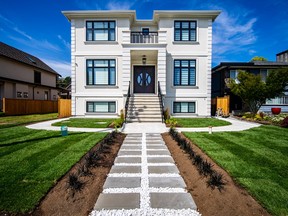Built Green Canada celebrates innovation, leadership and sustainable building practices with the Maverick Awards.

Reviews and recommendations are unbiased and products are independently selected. Postmedia may earn an affiliate commission from purchases made through links on this page.
Article content
Three Canadian home builders have been honoured for their green efforts as the inaugural edition of the Maverick Awards unveiled its winners.
Those winners, including one from Edmonton, are part of Built Green Canada’s desire to elevate and recognize excellence in sustainable building. Built Green rolled out the Mavericks as part of its efforts to mitigate the impacts of climate change and to help embrace change and progress in sustainable building practices.
Article content
The Ambassador Maverick, recognizing those who encourage and promote sustainable building, went to Kelly Williams of Sterling Homes Edmonton. Finalists in this category, in addition to Williams, were Jayman Built (both its Edmonton and Calgary offices) and Joe Geluch of Naikoon Contracting Ltd., North Vancouver.
The Innovation Maverick was awarded to Calgary-based Kanas Corp., recognizing creativity in advancing sustainable building. Kanas competed with Jayman Built (both its Edmonton and Calgary offices) and Ellenwood Homes of Nelson, B.C., to win the award.
Vancouver’s Major Homes won the Transformational Maverick, which acknowledges the impact sustainability practices can have in driving real change. Major faced two other finalists: Spring Creek from Canmore, and Citta Group for a project in Victoria — the company is based in Saanichton, B.C.
Advertisement 2
Article content
“We’ve been thrilled with the response to our inaugural Maverick Awards and are privileged to be able to shine a light on the incredible work being done in the built space,” said Jenifer Christenson, CEO of the Edmonton-based national organization. “Submissions were received from our builders in British Columbia through to Ontario.”
For Sterling’s Williams, it’s extreme weather across the planet that spurred her on.
“There is no ignoring the wildfires and extreme temperatures, and rather than feeling hopeless, I want to try in whatever way possible to help,” Williams said in the Maverick Awards entry. “I am inspired to make changes, in any and every way that I have the power to do.”
Also in that entry submission she said she wanted Sterling to advance its building practices toward net zero, and she would like to see Sterling’s customers benefit from the operational savings through its sustainable product line.
Sterling noted in that same entry that not only has Williams inspired a cultural and operational shift leading to incremental and substantive improvements in energy efficiency across its entire product line, but Williams has also proven that a volume builder can construct homes that are green and ones that continue to get greener.
Article content
Advertisement 3
Article content
Meanwhile, it was western Canada’s tallest insulated concrete form building that led to the Innovation Maverick win for Kanas.
The Orion at Lumino Park is a 115,000-square-foot, 135-unit residential high rise, with a state-of-the-art cogeneration system providing 534 kilowatts of electricity to the development in Calgary’s southwest sector.
In 2023, Kanas put the finishing touches on its Lumino Park development, specifically its most recent addition, the Orion building, which the company is citing as the crown jewel of its portfolio of Built Green certified properties. The development also has a heat recovery system, which provides energy for domestic hot water, heats the parking garage and melts snow on public spaces in the winter.
Kanas said in its award submission it believes all of its technologies and innovations are fully scalable and it’s taking lessons learnt and applying them into some of its newest developments in Calgary, in Bridgeland and the University District.
For the Maverick’s other award, Vancouver’s Major Homes, selected as the Transformational Maverick winner, it originally began as a traditional residential builder with an emphasis on spec homes. Now the family-run business focuses on sustainable and energy efficient homes.
Advertisement 4
Article content
In its entry submission, Major said the growing demand for environmentally conscious living spaces meant it needed to adapt to evolving market trends and as a result it made a strategic shift in its business model to achieve this.
Key sustainability features Major now uses include the integration of renewable energy sources, the use of eco-friendly building materials, and construction techniques to minimize environmental impact and promote healthy indoor air quality, the implementation of energy-efficient HVAC systems, appliances and lighting fixtures to reduce energy consumption and utility costs, and the adoption of water-saving technologies.
“Every day, we work alongside builders, renovators, restorers and developers and see remarkable leadership in sustainable building in what is still a burgeoning sector of the industry,” said Christenson. “Our three winners embody our mission to progress industry toward more holistic sustainable building practices — these are our trailblazers.”
The Mavericks, which occur primarily online, were judged by industry experts chosen to bring their extensive knowledge to the process, while their diversity in experience and geographic markets brought unique perspectives to the panel, Built Green said.
Advertisement 5
Article content
Built Green Canada is a non-profit organization working with builders interested in responsible sustainability practices in the residential building sector. It originated 21 years ago and was formed when builders wanted a means to progress and showcase their sustainability efforts through rigorous, relevant and practical third-party certification programs — voluntarily opting to do more than building code requirements. From this, they created Built Green with its founding member, Jayman Built, in collaboration with the Canadian Home Builders’ Association, Canada Mortgage and Housing Corp., the Alberta Research Council, Natural Resources Canada, Climate Change Central and other key stakeholders.
Article content





